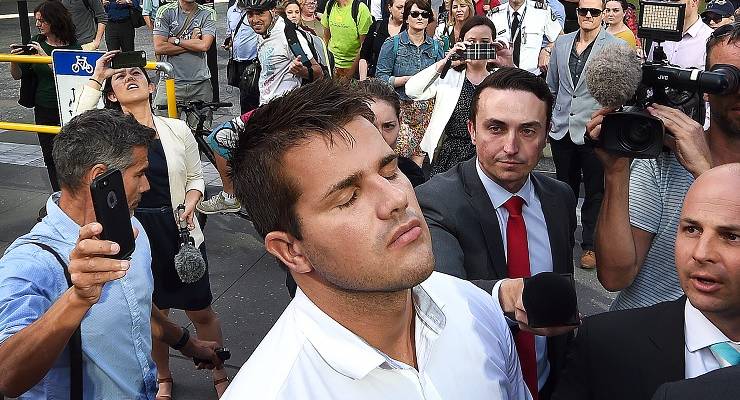
The Gable Tostee murder trial was sensational. In August 2014, Tostee met Warriena Wright on Tinder. They spent an admittedly wild night in a high rise apartment on the Gold Coast. It ended with Wright’s death, after she fell off the 14th floor balcony while trying to climb down to the level below.
The Crown case was that there had been a violent argument during which Tostee locked Wright out on the balcony. Terrified for her life, she tried to escape by desperate means. Tostee was charged with murder and, as an alternative, manslaughter. He was acquitted in 2016.
So far as the law is concerned, Tostee (under his new legal name Eric Thomas) is as good as innocent. To be clear, a not guilty verdict is not a declaration of innocence, but it is the end of the story.
However, in the real world the story may go on. All the more so in the social media age. For Thomas, digital footprints are cutting both ways. Reportedly he’s back on Tinder, as is his right. But he’s also being tracked and called out.
The online group Mad Fucking Witches (MFW) went after Thomas recently, posting his new Tinder profile on its Facebook page and sending an unequivocal message to its followers:
“He was acquitted of her murder, but we believe witches would want to know the identity of such a man before deciding to date him. And yes, Tostee met Wright on Tinder.”
Thomas says he’s going to sue the group for defamation, as well as people who have added comments along lines that aren’t difficult to imagine. MFW says it’s just trying to protect women from “men that we feel are making life worse for women”.
There’s more to this particular story, which covers none of the players in glory. It also neatly illustrates the wider issue of the intersection between the justice system and the individual’s right to protect their reputation.
When Geoffrey Rush won his defamation case with a finding on the balance of probabilities that he didn’t sexually harass a young actress, he asked the court for a permanent injunction against any future publication of the allegations. The idea was to scrub both the past and future records of the whole discredited suggestion.
He failed, because his reputational right was trumped by the principle of a free press. Whether the current appeal in his case succeeds or fails, the story will follow him forever.
Likewise for Thomas, to be realistic. That’s not to say that what MFW did was without legal risk; if Thomas sues, there will be a close examination of their exact words in context and their only viable defence will be truth.
However, there is a wide field available for the continued public exposure of Thomas’ presence and actions, referring the disinterested observer back to his past, in ways that will give him no legal recourse whatsoever.
The complexity here comes from the collision of rights. Free speech, although not legally protected in Australia, is still a baseline assumption to the extent it isn’t impinged by law. However, so is the right to privacy and the right to protect one’s reputation. The presumption of innocence, while not a right as such, also has a role to play in the balance between competing social norms.
The concept of free speech aligns to some extent with the desire of victims to tell their stories, and activists like MFW to both extend protection of vulnerable groups (like women) from known or perceived threats and to change society for the better by exposing the bad. But’s it’s not a neat fit. As the stall of the Me Too movement has illustrated, the law is not well adapted for this new dynamic.
Once the legal system is fully engaged, whether by criminal charges or a civil suit for harassment or worse, or by defamation proceedings, then things become a bit more clear because the system delivers answers of a sort. For example, if someone is convicted of a crime, their reputation barely exists anymore (if at all) and they’re easy prey for storytelling (case study: every series of Underbelly).
In a situation like Thomas’, it’s less clear-cut. Some of the boundaries are set by the legal verdict. It’s similar for Rush, but his reputation is better protected.
The point is that a search for the correct answer here is necessarily doomed. Whether viewed from the perspective of a victim of alleged wrongdoing, the alleged perpetrator of the alleged wrong, the hopefully impartial media trying to report something newsworthy, or bystanders who are seeking to extend a protective arc over future victims by sharing knowledge or suspicions of risk derived from what’s already transpired, it isn’t possible in any particular case to nail down with certainty which rights of which people should stand highest.
What can be said is that, in Australia, the balance is not appropriately set. It favours reputation over speech and, more damagingly, over the right of a victim to be heard.
That’s a major reason why MFW and their like have entered the field and are seeking to alter the balance using the power of the digital community. The law will, eventually, have to respond in a more imaginatively realistic way than it has been achieving to date.
In the meantime, the explosion of defamation suits will continue unabated, achieving little of societal value but creating plenty of work for lawyers.








Crikey encourages robust conversations on our website. However, we’re a small team, so sometimes we have to reluctantly turn comments off due to legal risk. Thanks for your understanding and in the meantime, have a read of our moderation guidelines.